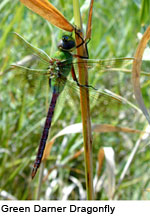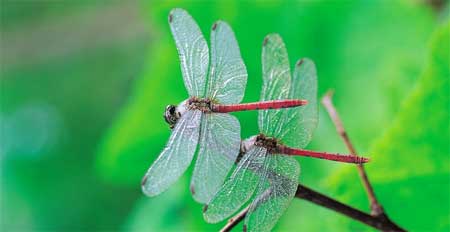|

 Diet: Dragonflies typically eat mosquitoes, midges and other small insects
like flies, bees, and butterflies. They are usually found around
lakes, ponds, streams, and wetlands because their larvae, known
as "nymphs", are aquatic. Dragonflies do not bite or sting
humans; in fact, they are valued as a predator that helps control
the populations of harmful insects, such as mosquitoes. Diet: Dragonflies typically eat mosquitoes, midges and other small insects
like flies, bees, and butterflies. They are usually found around
lakes, ponds, streams, and wetlands because their larvae, known
as "nymphs", are aquatic. Dragonflies do not bite or sting
humans; in fact, they are valued as a predator that helps control
the populations of harmful insects, such as mosquitoes.
Record breakers: Dragonflies are the world's fastest insects, capable of reaching
speeds of up to 60 mph. The Common Green Darner dragonfly is nicknamed "Darning Needle" because of its body shape. It is one
of the biggest
and fastest-flying dragonflies, able to reach speeds
of
53 mph.
Vision: Dragonflies have very good eyesight due to their unique eye structure.
Dragonflies have up to 30,000 facets to their compound eyes; each
one is a separate light-sensing organ or ommatidium, arranged to
give nearly a 360° field of vision.

Camouflage: It was recently discovered that dragonflies employ a particular
optical illusion, termed motion camouflage,
to stalk other insects
that invade their territory. A dragonfly can move in such a way
as to project itself as a stationary object while speedily attacking
its victims, new research suggests. These findings illustrate for
the first time how dragonflies use complex camouflaging techniques
during aerial combat.

The life cycle of the dragonfly, from egg to the death of an adult,
varies from six months to as much as six or seven years. Female
dragonflies lay eggs in or near water, often in or on floating or
emergent plants. Most of the life cycle is spent in the larval (nymph)
form, beneath the water surface, using internal gills to breathe,
and catching other invertebrates or even vertebrates such as tadpoles
and fish. In the adult (flying) stage, larger species of dragonfly
can live as long as four months.
All text is available under the terms
of the GNU Free Documentation License
|